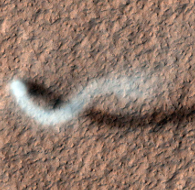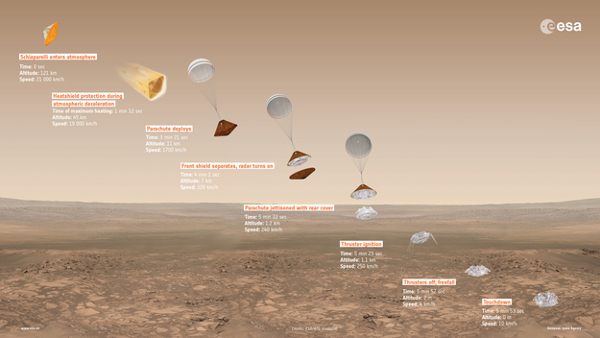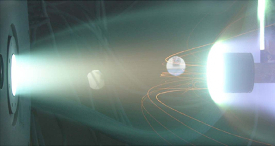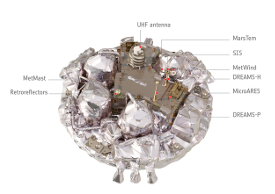A stormy arrival for Schiaparelli?
Fine dust is found everywhere on Mars. Even the sky appears orange because of suspended dust particles. Although the air is very thin – only about 1% as dense as Earth's atmosphere at sea level – strong winds are capable of picking up the smaller particles and lifting them many kilometres above the surface. They can also cause larger sand grains to bounce along the surface, dislodging other grains and, in time, contributing to the erosion of surfaces with which they come into contact.
There are countless localised dust storms during a Martian year. Most of these are associated with low-pressure systems or occur near the edges of the polar ice caps, where cold air meets warmer air over ice-free ground. Innumerable localised whirlwinds, known as dust devils, also pick up loose material as they sweep across the surface.
 |
.jpg) |
.jpg) |
| Left: Dust devil on Mars. Centre: Short-lived dust storm on Mars. Right: Global dust storm on Mars in 2001. (Click on images for larger versions and credits.) | ||
However, the changing seasons also play a major role. During the northern spring and summer, large dust storms are rare. The opposite is true of the northern autumn and winter – which coincides with perihelion, the closest approach of Mars to the Sun. In these latter two seasons, wind speeds increase and the likelihood of local or regional dust storms also increases.
On rare occasions, such as 1971 and 2001, regional dust storms may develop and merge until they eventually blanket the entire planet, so that the surface is hidden from orbiting spacecraft or Earth-based telescopes.
During these large storms, the widespread dust results in warming of the bulk of the atmosphere during the daytime, but the reduced sunlight reaching lower altitudes causes cooling of the air near the surface. Investigations into the resulting effects have played a major part in the preparations for the first mission of ESA’s ExoMars programme.
ExoMars 2016
Once it was decided to launch ExoMars toward the Red Planet during the 2016 launch window, the laws of physics determined that the spacecraft would arrive at Mars in October, during the northern autumn – usually a period of significant dust storm activity.
Three days before it enters orbit around the planet, the Trace Gas Orbiter (TGO) will release Schiaparelli on a ballistic trajectory that will send it plunging into the Martian atmosphere. Although any major dust storms will have little effect on the TGO, apart from partially obscuring the surface, an atmosphere disturbed by strong winds and rich in dust could have a significant impact on Schiaparelli.
 |
| Overview of Schiaparelli's entry, descent and landing sequence on Mars. Credit: ESA/ ATG medialab |
ESA's mission team and European scientists have analysed the likely effects of a regional or global-scale dust storm on Schiaparelli's descent and landing.
"We are unable to predict when global-scale dust storms will occur," said Luca Montabone, a member of the team at the Laboratoire de Météorologie Dynamique, Institut Pierre Simon Laplace, in Paris, which has been studying Martian dust events. "One occurs every few Martian years, but the most recent was in 2007.
"However, we do know that each Martian year, around the same time, atmospheric waves are generated between 40 and 80 degrees north, due to topography and temperature contrasts between the polar cap and the surrounding ice-free plains. The resulting surface winds lift dust and move it south toward the equator, picking up more dust on the way.
"Our analysis shows that the near-equatorial landing site of ExoMars 2016, in Meridiani Planum, lies close to a track that is frequently followed by dust-laden winds from the north, so Schiaparelli may be affected by local or regional storms.
"On the other hand, we have determined that these dust storms occur during two peak periods, with a hiatus in between, and Schiaparelli should arrive after the first peak, so we may be lucky. Fortunately, the ExoMars 2020 lander will arrive outside of the main dust storm season."
The presence of dust high in the atmosphere had to be taken into account during the planning of Schiaparelli's entry, descent and landing.
"We considered going into Martian orbit before Schiaparelli was released, but we eventually decided to save fuel and mass by choosing to release it from a hyperbolic arrival trajectory for a ballistic entry," said Thierry Blancquaert, ESA's EDM manager. "This means that the capsule will enter the atmosphere with a more accurate entry corridor, following a flight path angle of 12° with an entry corridor only 1° wide. However, the possible landing area spans an ellipse of 100 km by 15 km, due to the variability of the atmosphere.
"We were aware that an arrival in October would coincide with the planet’s dust storm season, so we had to go through a number of tests and verifications to ensure that all systems would survive and operate properly.
 |
| Testing the thermal protection system. Credit: CNES, HPS, DLR |
"One problem we looked at was erosion of the thermal protection material on the front heat shield, due to high speed impacts by dust particles during the entry phase. Dedicated wind tunnel tests with a dust-loaded flow allowed us to derive a dust erosion model that we used when we designed the heat shield. As a result, we increased the thickness of the ablative thermal protection material by 3 to 4 mm.
"Studies were made on the parachute materials to ensure that it would not be affected by the dust particles. The simulations verified that the parachute strength is adequate for the predicted changing atmospheric densities. We also had to take into account that the main parachute will deploy at an altitude of 11 km, when Schiaparelli is travelling at around 1,700 km/h.
"Uncertainties in the ballistic trajectory caused by horizontal and vertical winds, as well as density variations, meant that we defined a large landing ellipse some 100 km in length. However, we designed Schiaparelli to make a safe landing with horizontal winds up to 30 m/s and vertical winds up to 12 m/s, after jettisoning the parachute and making its final descent using onboard engines. Schiaparelli can actually tolerate much larger wind velocities at higher altitudes."
After various analyses, the mission team concluded that atmospheric dust would have little effect on Schiaparelli's radio communications, although the altitude and velocity measurements made by the radar during the descent would be slightly affected by a small attenuation of its return signals.
Less certain is the impact of discharges on the spacecraft caused by the build up of electrical charges in the dust-laden environment. Such discharges, including flashes of lightning in large dust clouds, are thought to be much less common on Mars than on Earth, but Schiaparelli has been designed so that electrical conducting areas are bonded to prevent the build up of these charges.
 |
| Schiaparelli with location of DREAMS sensors indicated. Credit: ESA/ATG medialab |
The DREAMS instrument package on Schiaparelli will make the first measurements of electric fields on Mars, providing data that will be of value in planning the second ExoMars mission and future human missions to the Red Planet.
"We don’t know if electrical discharges occur on Mars," said Francesca Esposito of INAF - Osservatorio Astronomico di Capodimonte, Naples, Italy, Principal Investigator for the DREAMS suite. "But it is generally thought that they can be created by collisions with dust particles of different sizes, which generate positive and negative charges. DREAMS will help us to understand if wind-blown dust can cause dangerous electrical discharges."
ExoMars 2020
Once it is on the Martian surface, Schiaparelli's scientific payload will start to operate, but since the lander's power is supplied solely by primary batteries, the lifetime of the module is expected to be between two and eight sols (Martian days). This means that dust storms and dust devils will have no impact on the surface mission. This is not the case with the next ExoMars mission, which is planned to arrive in 2020.
The larger lander and its European-built rover are expected to operate for 7 to 12 months, relying on solar panels for their power supply. Although ExoMars 2020 will arrive outside the main dust storm season, the mission is almost certain to be affected by dust during its operational lifetime. In particular, a build up of dust on the solar panels will reduce power supply and may necessitate a temporary shut down of surface operations.
The mission teams in Europe and Russia are also evaluating the impact of strong winds and dust on the much larger spacecraft and the two giant parachutes that are required to reduce its speed during descent. The first stage parachute will measure 15 m in diameter, with a 35 m diameter parachute as the second stage.
"Our Russian colleagues are also carrying out studies to understand the effect of dust on the heat shield on the much larger descent module," said Thierry Blancquaert. "The experience that we have already gained during the development of Schiaparelli and what we learn during the entry, descent and landing phase will be an important contribution to our preparations for this next mission."





